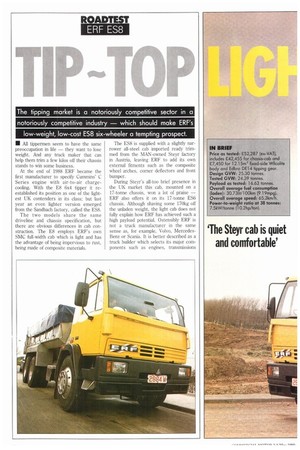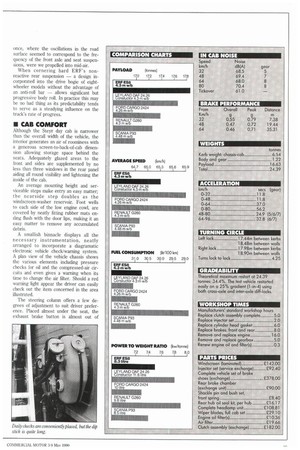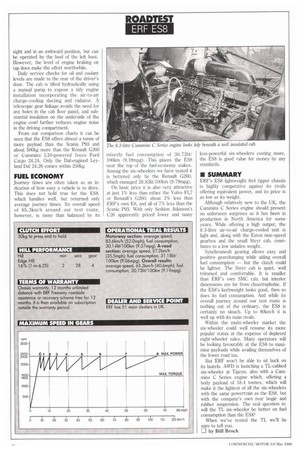The tipping market is a notoriously competitive sector in a
Page 82

Page 83

Page 84

Page 85

Page 86

If you've noticed an error in this article please click here to report it so we can fix it.
notoriously competitive industry — which should make ERF's low-weight, low-cost E58 six-wheeler a tempting prospect.
• All tippermen seem to have the same preoccupation in life — they want to lose weight. And any truck maker that can help them trim a few kilos off their chassis stands to win some business.
At the end of 1988 ERF became the first manufacturer to specify Cummins' C Series engine with air-to-air chargecooling. With the E8 6x4 tipper it reestablished its position as one of the lightest UK contenders in its class; but last year an even lighter version emerged from the Sandbach factory, called the ES8.
The two models share the same driveline and chassis specification, but there are obvious differences in cab construction. The ES employs ERF's own SMC full-width cab which is light and has the advantage of being impervious to rust, being made of composite materials. The ES8 is supplied with a slightly narrower all-steel cab imported ready trimmed from the MAN-owned Steyr factory in Austria, leaving ERF to add its invp external fitments such as the composite: wheel arches, corner deflectors and front bumper.
During Steyr's all-too brief presence in the UK market this cab, mounted on a 17-tonne chassis, won a lot of praise — ERE also offers it on its 17-tonne ES6 chassis. Although shaving some 170kg off the unladen weight, the light cab does not fully explain how ERF has achieved such a high payload potential. Ostensibly ERE is not a truck manufacturer in the same sense as, for example, Volvo, MercedesBenz or Scania. It is better described as a truck builder which selects its major components such as engines, transmissions and axles from proprietary ranges.
This approach has much to commend it: ERF is able to avail itself of many of the latest developments in driveline technology without incurring the huge development costs.
The 8.3-litre C Series engine is the latest in a range of power units to be introduced by Cummins since the late seventies onwards.
It fills a niche between the very successful L10 range and Cummins' smaller six-litre B Series engines.
Typical of modern diesels, but unlike any of the older units that power the models included in our comparison charts, it is charge-cooled, not only to maximise power output but also to help comply with future emission legislation. From a relatively small capacity it offers a high power-to-weight ratio.
Like Iveco Ford, ERF specifies the 6109 synchromesh gearbox, one of Eaton's more recent models.
Truck manufacturers who produce everything themselves contend that they are better able to match the performance of individual components. But proprietary component manufacturers point to their specialist expertise and are well aware of the compatibility requirements that are expected of them. So much depends on how well these major components perform, and it is no surprise that ERF is prepared to spend time and money to get their installation right.
As with all weight classes, installed power is on the increase; so much so that 183kW (245hp), which was 20% above the norm just four years ago, is now the aver■
age figure at 24.39 tonnes. The vast majority of tippers, whether six or eightleggers, still operate relatively close to base: high power in this type of operation ensures quick journey times and hence better productivity — in theory at least, for all the power in the world won't get you out of a traffic jam once you're stuck in the middle of it.
Over difficult terrain, however, it could make the difference in taking an extra load in the hours available, and where rates are tight that could make the difference between profit and loss. With the appropriate gearing high power can also provide economical cruising speeds, both on A-roads and motorways.
• PERFORMANCE
With the wind against us over the Ml section of our test route the ES8 rarely dropped below the legal limit at around 2,200rpm, yet returned a creditable 30.141it/100km (9.37mpg). Where traffic conditions caused us to slow down, the six-wheeler was quick to recover its cruising speed, and none of the motorway gradients we encountered were sufficient to force a downchange.
Over two-lane A-road sections the engine pulled well close to maximum torque and remained well in the green economy
_
band at about 1,800rpm over the faster dual carriageways. On the hillier parts of the route, gearchanging became more frequent; fortunately the short lever produces clean, quick engagement every time, despite the heavy clutch effort. The heavy clutch pedal is not a major problem, but it might cause fatigue in hilly or stopstart urban running where gear changing is more frequent.
• HANDLING
The power-assisted steering has a good feel to it, providing positive directional control, but it is not geared so low that it needs an excessive amount of winding on to complete tight manoeuvres at full lock.
The ride quality of a six-wheeler is never as good as an equivalent eight-legger, but with a fully adjustable driver's suspension seat we found little to criticise. Only once, where the oscillations in the road surface seemed to correspond to the frequency of the front axle and seat suspensions, were we propelled into mid-air.
When cornering hard ERF's nonreactive rear suspension a design incorporated into the drive bogie of eightwheeler models without the advantage of an anti-roll bar allows significant but progressive body roll. In practice this may be no bad thing as its predictability tends to serve as a steadying influence on the truck's rate of progress.
• CAB COMFORT
Although the Steyr day cab is narrower than the overall width of the vehicle, the interior generates an air of roominess with a generous screen-to-back-of-cab dimension allowing storage space behind the seats. Adequately glazed areas to the front and sides are supplemented by no less than three windows in the rear panel aiding all round visibility and lightening the inside of the cab.
An average mounting height and serviceable steps make entry an easy matter; the nearside step doubles as the windscreen-washer reservoir. Foot wells to each side of the low engine cowl, are covered by neatly fitting rubber mats ending flush with the door lips, making it an easy matter to remove any accumulated debris.
A smallish binnacle displays all the necessary instrumentation, neatly arranged to incorporate a diagramatic electronic vehicle check/warning system. A plan view of the vehicle chassis shows the various elements including pressure checks for oil and the compressed-air circuits and even gives a warning when its time to change the air filter. Should a red warning light appear the driver can easily check out the item concerned in the area illustrated.
The steering cokunn offers a few degrees of adjustment to suit driver preference. Placed almost under the seat, the exhaust brake button is almost out of sight and in an awkward position, but can be operated by the heel of the left boot. However, the level of engine braking on tap does make the effort worthwhile.
Daily service checks for oil and coolant levels are made to the rear of the driver's door. The cab is tilted hydraulically using a manual pump to expose a tidy engine installation incorporating the air-to-air charge-cooling ducting and radiator. A telescopic gear linkage avoids the need for any holes in the cab floor panel, and substantial insulation on the underside of the engine cowl further reduces engine noise in the driving compartment.
From our comparison charts it can be seen that the ES8 offers almost a tonne of more payload than the Scania P93 and about 500kg more than the Renault G260 or Cummins L10-powered Iveco Ford Cargo 24.24. Only the Daf-engined Leyland Daf 24.26 comes within 250kg.
FUEL ECONOMY
journey times are often taken as an indication of how easy a vehicle is to drive. This does not hold true for the ES8, which handles well, but returned only average journey times. Its overall speed. of 65.3km/h around our test route, however, is more than balanced by its miserly fuel consumption of 30.731it/ 100km (9.19mpg). This places the ES8 near the top of the fuel-economy stakes. Among the six-wheelers we have tested it is bettered only by the Renault G260, which managed 28.831it/100km (9.79mpg).
On basic price it is also very attractive at just 1% less than either the Volvo FL7 or Renault's G260; about 2% less than ERF's own E8, and all of 7% less than the Scania P93. With only Seddon Atkinson's C26 apparently priced lower and many less-powerful six-wheelers costing more, the ES8 is good value for money by any standards.
• SUMMARY
ERF's ES8 lightweight 6x4 tipper chassis is highly competitive against its rivals offering equivalent power, and its price is as low as its weight.
Although relatively new to the UK, the Cummins C Series engine should present no unforseen surprises as it has been in production in North America for some years. While offering a high output, the 8.3-litre air-to-air charge-cooled unit is light and, along with the Eaton nine-speed gearbox and the small Steyr cab, conributes to a low unladen weight.
Synchromesh gearing allows easy and positive gearchanging while aiding overall fuel consumption — but the clutch could be lighter. The Steyr cab is quiet, well trimmed and comfortable. It is smaller than ERF's own SMC cab, but interior dimensions are far from claustrophobic. If the ES8's kerbweight looks good, then so does its fuel consumption. And while its overall journey around our test route is nothing out of the ordinary, the ES8 is certainly no slouch. Up to 80kmill it is well up with its main rivals.
Within the multi-wheeler market the six-wheeler could well resume its more popular status at the expense of depleted eight-wheeler sales. Many operators will be looking favourably at the ES8 to maximise payloads while availing themselves of the lower road tax.
But ERF won't be able to sit back on its laurels. AWD is launching a TL-cabbed six-wheeler at Tipcon, also with a Cummins C Series engine which, offering a body payload of 18.4 tonnes, which will make it the lightest of all the six-wheelers with the same powertrain as the ES8, but with the company's own rear bogie and rubber suspension. The real question is: will the TL six-wheeler be better on fuel consumption than the ES8?
When we've tested the TL we'll be sure to tell you.
by Bill Brock








































































































































































